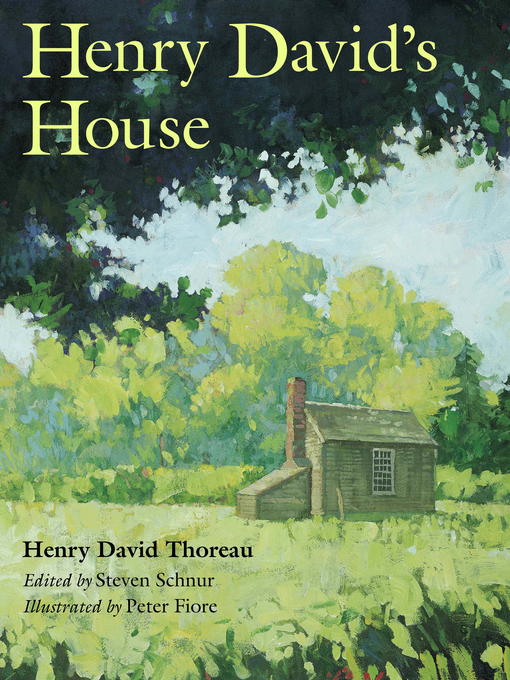Young readers are introduced to Henry David Thoreau's masterpiece, Walden, through excerpts from the original work.
-
Creators
-
Publisher
-
Release date
April 14, 2011 -
Formats
-
OverDrive Read
- ISBN: 9781607342618
-
PDF ebook
- ISBN: 9781607342618
- File size: 16094 KB
-
-
Languages
- English
-
Reviews
-
Publisher's Weekly
February 4, 2002
Schnur (The Shadow Children) deftly plucks Thoreau's own words from Walden, and Fiore's (The Boston Tea Party) luminous watercolor and oil paintings affectingly evoke the simplicity and serenity of this man's existence on his beloved pond. As Thoreau chronicles a key chapter in his life—his 1845 construction of the one-room cabin that became his treasured abode—he repeatedly marvels at the sights and sounds of the natural world, constantly changing with each season. Schnur's chosen passages reveal Thoreau as a participant in rather than merely an observer of nature: "Sometimes a rambler in the wood was attracted by the sound of my axe, and we chatted pleasantly over the chips which I had made." Spare yet eloquent, Thoreau's words offer intriguing insight into his lifestyle as well as his philosophy. Describing the minimal contents of his house, he notes, "My furniture, part of which I made myself, consisted of a bed, a table, a desk, three chairs (one for solitude, two for friendship, three for society)." Fiore's striking panoramas underscore the beauty and the appeal of the locale that became Thoreau's home and inspiration, while the interiors and spot art emphasize the simplicity of his lifestyle. Ages 5-9. -
School Library Journal
May 1, 2002
Gr 4-8-Using selected highlights of Thoreau's own words, this picture-book adaptation of Walden, or Life in the Woods follows Henry David's building of his cabin, from borrowing neighbor Bronson Alcott's axe in March of 1845 to his first spring on Walden Pond. Because the words are exact quotes, the language is rather difficult at times, using a style and vocabulary that are more formal than that of modern language. In addition, while most of the text is written in the past tense, the part in which Thoreau describes his completed house uses present verb forms and, thus, is a bit unsettling to the ear. Still, the overall effect of the words is to establish a mood of tranquility. That mood is greatly reinforced by the full-page watercolor illustrations, and their impressionistic style often focuses on selected aspects of the author's descriptions, rather than trying to retell the complete story visually. The soft palette underscores the peacefulness and quiet in Nature that Thoreau went out to seek. While this book is not likely to be embraced by casual readers, it will be particularly useful to teachers of art and science, and to literature specialists interested in introducing listeners either to Thoreau's literary style or to the concept of journal writing. Consider also pairing it with some nature poetry to inspire students in creative-writing classes.-Nancy Menaldi-Scanlan, LaSalle Academy, Providence, RICopyright 2002 School Library Journal, LLC Used with permission.
-
Booklist
April 1, 2002
Gr. 2-4. "Near the end of March I borrowed an ax and went down to the woods near Walden Pond . . . ." In brief, easy-reading passages chosen by Schnur, Thoreau describes the construction of his famous cottage, lists the possessions he filled it with, and tallies sights and sounds of the changing seasons, concluding, "We can never have enough of nature." Fiore's dappled, impressionistic woodland scenes make the sentiment easy to comprehend, though because his view is more often turned away from the actual house than toward it, children will see less of the building than its setting. Libraries needing a follow-up to offer picture-book audiences intrigued by Johnson's "Henry Hikes to Fitchburg" (2000) or "Henry Builds a Cabin" [BKL Mr 15 02] will be well served by this pleasing, sun-dappled picture book for older children. Schnur's afterword provides context. (Reprinted with permission of Booklist, copyright 2002, American Library Association.) -
The Horn Book
July 1, 2002
Using Thoreaus own words, Schnur judiciously adapts "Walden" for a younger audience. Thoreau describes how he builds a one-room cabin in the woods near Walden Pond and closely observes the seasons changing around him; on the final spread he marvels, "We can never have enough of Nature." Impressionistic paintings handsomely capture the surroundings that inspired Thoreau.(Copyright 2002 by The Horn Book, Incorporated, Boston. All rights reserved.)
-
Formats
- OverDrive Read
- PDF ebook
Languages
- English
Loading
Why is availability limited?
×Availability can change throughout the month based on the library's budget. You can still place a hold on the title, and your hold will be automatically filled as soon as the title is available again.
The Kindle Book format for this title is not supported on:
×Read-along ebook
×The OverDrive Read format of this ebook has professional narration that plays while you read in your browser. Learn more here.




